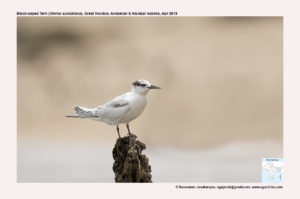Black-naped Tern
Black-naped Tern Sterna sumatrana
Etymology:
- Sterna : Old English name “stearn” for terns , believed to be derived from Danish and Norwegian terne or Swedish tärna
- Sumatrana: From Sumatra islands, Indonesia
Vernacular Name : Nicobar: Sannayena, Mald: Kirruddoni, Mar: KalyaManechasuray
Distribution in India: Resident of Andaman & Nicobar Islands in India.
Description: Size of 34–35 cm; Wt. of 98–100 g. The forehead and crown are white. It has a black band from eyes around nape, in side view appearing to sweep sharply down back of neck, contrasting with white crow. The upperparts are very pale grey; tail is white with grey center, deeply forked; outer web of outermost primary is black; underparts are white, often with rosy tinge; bill is black, occasionally with slight yellow tip; legs are black. The non-breeding adult is similar, but nuchal band is reduced. The juvenile has buffy head mottled grey or black, black nape, and pale grey upperparts with blackish chevrons; lacks pink tinge below. The race mathewsi has shorter wings and longer bill.
Habitat:It is found in small rocky, coral and sandy offshore islands, reefs, sand spits and rocky bays.
Food habits: It eats small fish. It always forages singly, occasionally in company of Black Noddy over predatory fish. It feeds mainly by shallow plunge-diving, also by surface-dipping and occasionally swim-dipping. It feeds in lagoons and close inshore over breakers, but sometimes at sea.
Breeding habits: They breed in May in India and Polynesia, Sept–Nov in Indian Ocean, Sept in tropical NE Australia, and Nov–Dec on S Great Barrier Reef. It usually forms small colonies and colonies are often mono-specific, but may be associated with Roseate tern or Bridled tern. The nest is an unlined depression in sand or in gravel or pockets on coral banks, close to high-tide line, sometimes demarcated with shell or with fragments of coral; also on or next to vegetation.They lay a clutch of 2–3 eggs. The incubation period is 21–23 days. The chicks are brooded and shaded for seven days. The adults mob predators and also give plover-like “ungulate” display with upright posture and spread wings.
